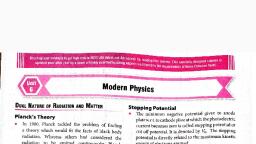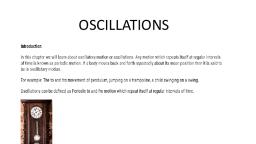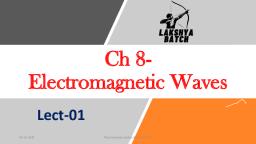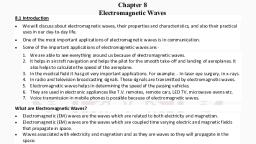Page 1 :
ELECTROMAGNETIC WAVES, , Introduction, , © We will discuss about electromagnetic waves, their properties and characteristics, and also their practical uses in our, day-to-day life., © One of the most important applications of electromagnetic wavesis in communication., , © Some of the important applications of electromagnetic waves are:, We are able to see everything around us because of electromagnetic waves., , It helps in aircraft navigation and helps the pilot for the smooth take-off and landing of aeroplanes. It also helps to, calculate the speed of the aeroplane., , In the medical field it has got very important applications. For example: - In laser eye surgery,in x-rays., , In radio and television broadcasting signals. These signals are transmitted by electromagnetic waves., Electromagnetic waves helps in determining the speed of the passing vehicles., , They are used in electronic appliances like T.V. remotes,temote cars,LED TV,microwave ovens etc., , Voice transmission in mobile phones is possible because of electromagnetic waves., , What are Electromagnetic Waves?, , Electromagnetic (EM) waves are the waves which are related toboth electricity and magnetism,, , Electromagnetic (EM) waves are the waves which are coupled time varying electric and magnetic fields that propagate, in space., , Waves associated with electricity and magnetism and as they are waves so they willpropagate in the space., , When the electric and magnetic fieldscombinetogether and whenthey are varying with time they both will give rise to, electromagnetic waves., , Electromagnetic equations emerged from Maxwell's equations, , Maxwell found these EM waves have so many special properties which can be used for many practical purposes., , Time varying electric field + Time varying magnetic field = Electromagnetic waves.
Page 2 :
Maxwell's Experiments, o Maxwell proposed that the time varying electric field can generate magnetic field., © Time varying magnetic field generates electric field (Faraday-Lenz law)., , According to Faraday Lenz law an emf is induced in the circuit whenever the amount of magnetic flux linked with a circuit, changes., , As a result electric current gets generated in the circuit which has an electric field associated with it., , Magnetic lines,, Magnet, , vant
Page 3 :
MAXWELL’S EXPT, , © According to Maxwell if Faraday’s law is true then the vice-versa should also be true, i.e. a time varying electric field, should also be able to generate amagnetic field., , © According to Ampere's Circuital law, the line integral of magnetic field over the length element is equal to 1, times the, total current passing through the surface Jdl = Hy!, , © According to Maxwell there was some inconsistency in the Ampere's circuital law., © This means Ampere's circuital law was correct for some cases but not correct for some., , © Maxwell took different scenarios i.e. he took a capacitor and tried to calculate magnetic field at a specific point ina, piece of a capacitor., , © Point P as shown in the figure is where he determined the value of B, assuming some current | is flowing through the, circuit., , o He considered 3 different amperial loops as shown in the figs., , o Ampere's circuital law should be same for all the 3 setups., , Case 1: Considered a surface of radius r & dl is the circumference of the surface, then from Ampere's circuital law, JB.dl = pg!, , or B(2mr) = Ug!, , orB= ol / 2nr, , B= (\lol/2 Tr)
Page 4 :
MAXWELL’S EXPT, , Point P where to determine the, value of magneticfield G.., 4,, , , , , , , on, Current | flowing. <2, Current | +, Surface as Amperial ;, loop Capacitor C, Radius r,C=2Tr, , Case 2 : Considering a surface like a box & its lid is open and applying the Ampere's circuital law, , [B.dl= yy!, , perial loop, , , , , , loop is inside the, , , , aoa. Fi E capacitor, Current | flowing + 1p., outside the (20: No cuarentt, capacitor the capacitor, Capacitor C
Page 5 :
As there is no current flowing inside the capacity, therefore | = 0, , or B.dl=0, , Case 3: Considering the surface between 2 plates of the capacitor, in this case also I=0, so B=0, , , , , , , , Case 3;, Bel) Amperial loop is between, p +R the plates of the capacitor., Point P/4\1 5, Current | ’, Current | flowing ~ 1=0; No current inside, outside ji, thi, the capacitor Ecopecios, , , , , , Capacitor Cc, , o Atthe same point but with different amperial surfaces the value of magnetic field is not same. They are different for, the same point., , o Maxwell suggested that there are some gaps in the Ampere's circuital law., , o He corrected the Ampere's circuital law. And he made Ampere's circuital law consistent in all the scenarios.











































































